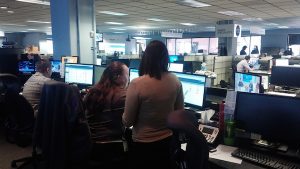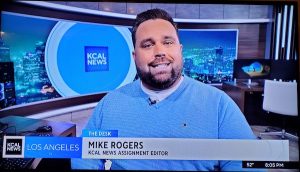1 The Newsroom
Introduction
Welcome to the television newsroom. Around 3:30 p.m. crews are returning from the field, producers are getting their afternoon shows straightened up, reporters are writing scripts, and editors are hunting down video and getting it cut.
It’s hard to find a place with more buzz and energy, but we’re getting ahead of ourselves. Let’s go back to the morning and a take a look at the jobs in a typical newsroom. In a smaller market, one person might perform several of these jobs, while bigger-market stations may divide one job among several people.
Director
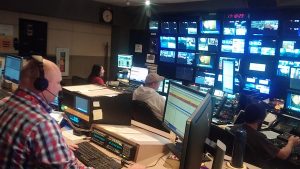
The newscast director runs the booth. He or she calls the shots when the newscast airs and is the one making commands like, “Ready camera one—take!” Hours before, and during, the newscast the director works with the producer to make the producer’s plan a technical reality. The director may also supervise, train and schedule the rest of the crew.
Technical Director
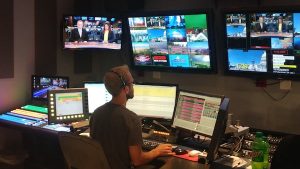
This person sits in front of the video switcher and punches the buttons to bring up the cameras, video, graphics, and other sources. With advancing switcher technology, some stations have the director do both jobs. This can be done by pre-programming the show ahead of time.
Audio Board Operator
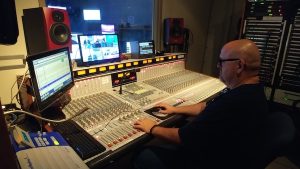
This person turns on the microphone when an anchor talks (and hopefully off when the anchor is done), lets the video and live sources be heard, and brings in the music. This position is getting to be more rare as companies automate newscast switching.
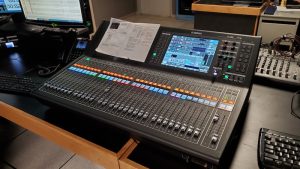
This is the audio board at KGET in Bakersfield during the newscast. No one is near is because it is linked to the switcher’s commands. The single slider is up for a video source. When the technical director switches back to the studio camera, the video slider will automatically come down and the sliders for the studio microphones will come up.
Teleprompter
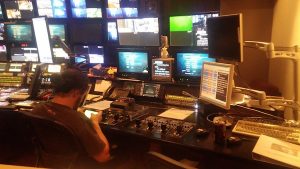
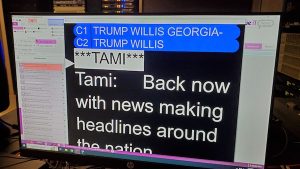
When the anchor looks right into the lens and speaks, they’re probably reading the script reflected over top of the lens. The prompter operator scrolls the words like movie credits (but much faster) keeping the lines in the right place to be read by the anchor. When you see an anchor suddenly stumble over their words and look down at their scripts a lot, something has gone wrong with the teleprompter.
Studio Camera
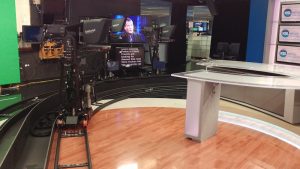
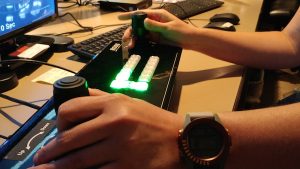
These are the people who move cameras around and set them up, mostly pointing at the anchors. The exceptions are close shots for things like cooking segments. 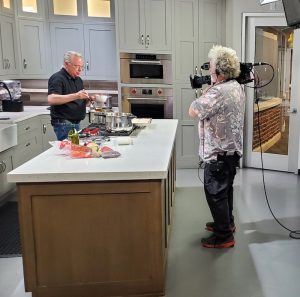
Because the shots are consistent day after day, studio cameras are getting roboticized; this means one person can control several cameras remotely and automation may eliminate the controller position entirely.
Floor Director
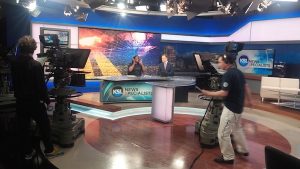
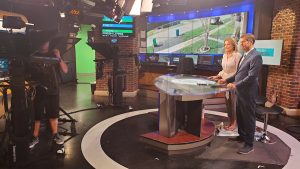
This person is out in the studio with the anchors. He or she listens to the director’s cues on their headsets and conveys the information to the anchors, often non-verbally. For instance, if the newscast is showing video and the next thing on the rundown is the anchor talking into Camera two, the floor director will make a ready sign above Camera two. When the director calls “take” for Camera two, the floor director points to the lens purposefully, which lets the anchor know when and where to talk.
All of the above jobs fall under news production. They put the newscast on the air live from the studio. The following jobs originate from the newsroom, but may go far beyond it.
Assignment Desk
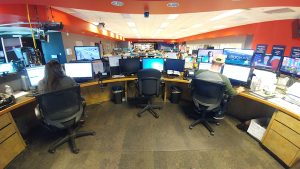
This is a place and a position. The desk can have 2-10 police and fire scanners on it, depending on your market’s coverage area, chattering all day long. This is also where incoming newsroom calls are answered. And if there’s a programming problem after business hours, they’ll answer questions about why some viewer’s favorite show isn’t on tonight. The two-way radio base station, paging, contact lists, maps and other information are also kept here.
“The desk” also refers to the person/people staffing it. If there are several, one is usually called the “Assignment Manager” and oversees the others. The desk listens to the police and fire scanners, answers phones, sets up interviews, reads press releases and monitors social media. Should they hear something interesting on a scanner, they would call the dispatch center to confirm and/or get more details. They would then tell a producer about it, and if the producer wanted the story checked out for the show, they would send a photographer or reporter/photographer team to drive to the scene. If all crews are already working on other stories, desk and producer would decide which crew to pull from a story. The original story might get kicked down to a smaller version, held for another shift or day, or maybe it gets dropped altogether; it depends on the story and progress already made on it.
The assignment desk is not a glory position. They end up listening to whining from both viewers and crews, but it is the hub of activity in the newsroom — almost everything done in a day of news-gathering channels through it. Former KUTV assignment manager and KCAL assistant operations manager, Mark Biljanic, said the job requires “the willingness to learn what news is, and be able to multitask. Really have a brain…keeping track of reporters and photographers in the field, and move chess pieces around efficiently and know who to call when.”
An assignment editor going live near the desk at KCAL in Los Angeles. He read some quick VOs on spot news events. Being on TV is the exception for assignment desk duties.
Photographers
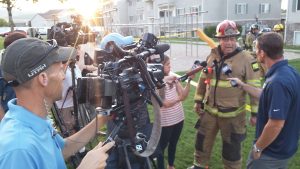
These are the people with the cameras on their shoulders driving out to shoot the stories. Even though they shoot video on video cameras, they are called “photographers,” often shortened to “photog.” Possibly due to the weight of the early equipment, photography staffs run 90 percent male. Now that cameras, batteries and tripods are smaller, people not built like offensive linemen can handle the gear. Women are highly sought after for this position.
Photographers are typically paid less than reporters but can close the gap some if they have a take-home news vehicle and can work overtime.
On a typical day, a photographer arrives to work, and if not allowed a take-home vehicle, will load up his or her gear in a station vehicle as he or she checks batteries, memory cards and vehicle fuel to make sure they are ready for the day. The assignment desk will then give them a list of assignments to shoot on their own or pair them with a reporter for the day. They may be asked to edit their own, or someone else’s video, in a station edit bay or a laptop computer in the field. Photographers may also run live equipment including backpacks, microwave trucks, and if trained, the station’s satellite truck.
NASA trained its astronauts how to run their own cameras, and scuba divers do the same; everything in between, from stunt planes to underground mining, a photographer has shot. Photographers go everywhere. This can be exciting and/or dreadful, depending on where you go.
Reporters
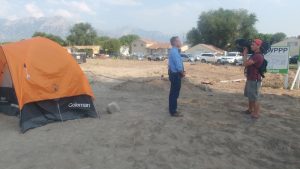
These are the people in the field. Working with photographers, they set up interviews, conduct them, log them (choose the best parts to use as “soundbites”), write a script, record their voice and often introduce the edited story live in the studio or the field.
Reporters must maintain a professional appearance since they represent the station on television and to those they seek to interview. They may be assigned stories but are expected to come up with their own ideas too.
Multi-Media Journalist (MMJs)
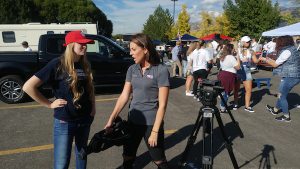
This term replaced “One-Man Band,” which is a reporter who runs their own camera for their story. “MMJ” sounds more modern, but if they shoot just for TV, it’s not actually “multi.” Small starter markets use MMJs almost exclusively, but you can find MMJs in some large markets, too. Doing the job of a reporter and photographer at the same time gives you more freedom, but can also be hard work.
Producers
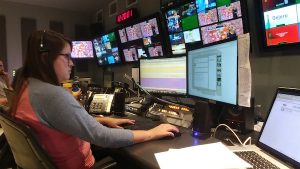
These staffers are assigned to a specific show and decide what stories, and how much of them, they will use to fill the show. They write the anchors’ copy and time the entire show, live from in the control booth. They will work an eight-hour shift that ends with their show. There is a forthcoming chapter exclusively about producing.
Associate Producers
APs assist producers in writing the show. They may be assigned anchor packages, voice-overs, teases or anything else the producer asks. Most are trained to become producers themselves.
Executive Producers
Usually former producers themselves, they oversee producers. They coordinate between shows (if there’s a major story, they might see that all shows don’t use the exact same material), edit and approve scripts and may help with scheduling.
Assistant News Director
This position is between EP and news director, and so are its responsibilities. An assistant news director might work on the editorial, logistics and scheduling in a newsroom.
News Director
This is the boss of the newsroom, typically answering to the station’s general manager. He or she oversees everything described in the preceding jobs. In addition, hiring, firing, audience research, news philosophy and direction, and discipline falls on the news director.
As mentioned earlier, this list expands or contracts, depending on market size. In very small markets, it is not uncommon for a weekend anchor to act as desk and producer, shoot some video in the field and use a foot controller to run their own teleprompter. By “not uncommon” we mean “don’t complain if you’re asked to do everything.”
The Planning Meeting
At the start of each shift, usually once in the morning and again in the early afternoon, all hands gather for the planning meeting. Reporters present their story ideas, the desk presents what is in the daybook, and producers choose what they want in their shows. Their choices are governed by management and the day’s logistics.
Story ideas come from:
Press Releases
Public Relations firms and amateurs pitch stories via email, U.S. mail, telephone and in person. Some of these stories are worthwhile and others are business-promoting fluff.
Social Media
See above, and add trending topics and observations from your local viewers and population.
Other Professional Media
Television newsrooms subscribe to all the local newspapers and newspaper newsrooms have TVs in them.
Wires
Besides Associated Press, newsrooms get constantly updated feeds from their affiliates, e.g., NBC and CNN.
Viewer tips
These can come in via telephone, email or social media. Some will make you shake your head. Others will have you turning it. Do not ignore all the eyes and ears out there that think to notify you when they see something going on.
Enterprising
Staff should be thinking of questions and possible story ideas everywhere they go. Everybody has a story. A simple tip for this came from a National Press Photographers Association speaker who advised photographers to drive back to the station using a different route than the one they took to the story; this exposes you to more of your community.
Police and Fire Scanners
The time you stop listening is the time some major news breaks in your area and you’ll miss it. Stories I’ve picked up off a scanner besides fires and shootings include:
- A four year-old boy who caught a fish bigger than he was in a city park
- Wild dogs that were killing cattle over the course of weeks
- Valets at a restaurant who were doing burnouts in customers’ cars in the parking garage next door; the tire smoke was so bad someone thought there was a fire.
From a compiled list from the above sources, or just ideas thrown out there, producers and managers choose the story and its treatment.
Television is a different medium than print, web and radio. The story selection criteria is different, too.
First, we consider newsworthiness. The PBS Newshour Student Training Manual (https://d12grbbaljejv6.cloudfront.net/wp-content/uploads/2016/05/Worksheet-1.1.pdf) lists five criteria:
1. Timeliness
Things that have just happened are “fresh” and new. Besides new information, the timeliness of a story can be affected on an hourly level: If a story happens around the time of a newscast, it lends itself to live reporting, especially for breaking news. In Utah, Governor Herbert has started important announcements at 5:02 p.m., lending itself to a news open, anchor toss to a reporter live, and the reporter can quickly introduce the governor who is just arriving at the podium.
2. Proximity
Local news affects people in the area. The farther away the story, the more extraordinary it needs to be. In your area, a minor traffic crash that snarls traffic may affect hundreds of your viewers, but U.S. media also covered a traffic jam in China in 2015. Why? Because it was 50-lanes wide with hours of waiting. Another in 2010 had some Chinese drivers waiting in for five days; that was extraordinary enough for most producers.
3. Conflict and Controversy
“When violence strikes or when people argue about actions, events, ideas or policies, we care. Conflict and controversy attract our attention by highlighting problems or differences within the community.” This can be a pair of Trump vs. anti-Trump rallies, or simply one of your locals taking on city hall or even a neighbor. Make sure you have both sides of the issue covered.
4. Human Interest
Everyone has a story, and some are amazing. People overcome great obstacles, handle crises or can just be amusing. PBS says we like these stories because we can identify with them. They are seldom lead stories, however.
5. Relevance
“People are attracted to information that helps them make good decisions,” PBS says. Information about hobbies, consumer prices or a proposed law can and will affect your viewer’s lives. Viewers will be drawn to these stories and you have an obligation to provide them (maybe not the hobbies part). KTVX in Salt Lake City had a series of posters on the walls of its newsrooms to help producers target their product. The posters showed the results of audience research they had done where viewers tell what’s important to them.
When I was doing live feature reporting on Saturday mornings, I stayed away from wacky setups; instead, I tried to show viewers a good option for where to spend their day off. Eventually, that show became the highest-rated morning show of the week.
Bonus: Prominence (This is not one of the PBS criteria)
The more famous a person is, the more likely things they do will be of interest to your viewers. If someone throws an egg at a neighbor’s house, has his car stolen or gets arrested for a DUI, is that news? It is if that person is Justin Bieber, your city’s mayor or a local news anchor, respectively.
I grumble about the interest our society has on celebrities, but cannot deny it. When a woman and her date were killed in car wreck half a world away, my wife was glued to her TV for days because the woman was Princess Diana. Following the same formula as the other criteria, the more famous/local the person is, the more newsworthy the things they do will be.
Other factors come into play every day.
What are the other stories of the day? While other media may be able to expand or contract as needed, television news programs are precisely timed and must fit into a finite slot (as a rule, though major breaking news can expand as needed). Bigger stories may push out human-interest stories for the day. The good news is human interest stories are often evergreen (non time-specific) enough to be run later, when things calm down.
News Philosophy
This can be dictated by a news director and heavily influenced by your programming. When KTXL-TV in Sacramento picked up the Fox affiliation, its politically-heavy, buttoned-down newscast gradually adapted to the style of Fox programming, even calling the approach “Foxified.” One of KTXL’s competitors — KRBK at the time — had an “If it bleeds, it leads” philosophy for a time. Another, KXTV, tried family-friendly for a while, not showing any body bags or disturbing footage.
What is your lead-in? Who is watching that night that you can draw in with teases? Your sales department knows. When I finished an in-depth piece about animals at the local shelter, my station’s promotions director suggested we run the piece on a Wednesday night, since that’s the night we had the highest percentage of pet ownership.
Indeed, we ran teases during breaks in programming, introducing viewers to Tank the dog and asking them to watch the news to see if Tank gets adopted. Viewers called in throughout the evening offering to take Tank. Pit Bull Tank was already in a good home before the story ran.
It is important to consider your medium when choosing stories, or at least their treatment. Television is the medium of motion and sound. Used properly, it is powerful. Budget stories, stories of future events or other stories where there’s no obvious thing to point the camera at, present a challenge. Some stations may shy away from these stories, but they can be done; it just takes more effort and some ingenuity.
It has been said, “there are no boring stories, only boring reporters.” While many reporters might argue that saying, a visual story will often take precedence over a non-visual one.

